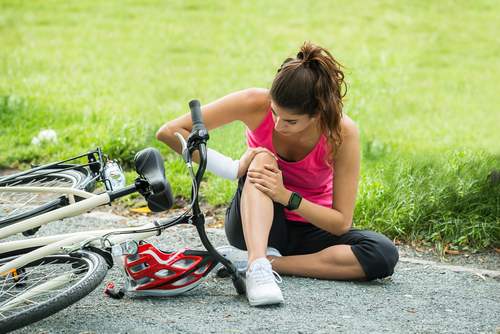So, you have injured yourself cycling and you are not sure what to do. You have tried stretching, you’ve tried massage, you’ve tried Aleve, you’ve had your bike refit, you’ve even taken two weeks off the bike and you still hurt. You’re now wondering if you will ever be able to ride pain free again. Life is looking gloomy and your bike is collecting dust.
Don’t give up yet.
Common injuries we treat in cyclists include neck pain, low back pain, hamstring strains, and calf or Achilles tendon strains. Each injury is usually a result of overstressing one area and underuse of another, combined with specific areas of weakness. These imbalances are amplified as you increase in miles, climbing or speed. In each case, the injury has been a result of cumulative trauma. Repetitive motion tends to tighten muscles. A tight muscle that remains tight tends to weaken. A weak muscle tends to tighten, and the cumulative trauma cycle continues.
Tight and weak muscles are also vulnerable to internal frictions, pressures, or tensions that may cause an acute inflammation even without a specific injury. This leads us to the “I didn’t do anything, it just started to hurt” phase. Inflammation cues the body to repair itself, which can result in the formation of fibrosis or scar tissue between tissues. Over time, fibrotic tissue is no longer capable of the same blood flow or circulation and the downward cycle is perpetuated.
Active Release Techniques® (ART®) is a soft tissue management system that breaks up adhesions in and between tissues. Using ART, normal length and tension of tissues are restored. For those of you who have tried stretching and general massage with no avail, ART may be exactly what you need.
Neck pain
Neck pain is a more common cycling injury than you might realize. The road cyclist’s seated position is with the low and mid-back flexed forward with arms reaching forward to grasp the handlebars. The neck is extended and the head is then raised to allow the cyclist to see out from under the helmet and down the road. As a result, a hinge is created between the upper back and the lower neck. This “hinge” is overstressed while the upper and mid-back remain stiff and weak. Cyclists often have a posture even off the bike with slightly rounded shoulders, flexed upper back and forward head.
Treatment of this type of problem consists of loosening (using ART and spinal mobilization) and strengthening the spine and muscles of the mid-back and shoulder blades. Postural corrections on and off the bike are also suggested.
Low back pain
Chronic low back pain in cyclists is often aggravated by pushing a big gear or with lots of climbing. More often than not, these folks have tight and weak glutes, hamstrings, and hip flexors (psoas) and poor core stability.
Ideally, the low back (lumbar spine) is supported by the deep abdominal muscles (transverse abdominis) and deep back muscles (multifidi) in a fairly static or still position as the legs move steadily around, providing power to the pedals. The power muscles for time trials and long hill climbs are the quadriceps to extend the knee and the glutes and hamstrings to extend the hip. If the power muscles are tight and weak and the lumbar or core stabilizers insufficient, extra movement either flexion-extension, side bending or shearing can occur in the lumbar spine. This extra friction, pressure or tension on the lumbar structures can cause pain, inflammation and eventually cumulative trauma.
Treatment includes ART to the lumbar spine, hip and hamstrings to regain normal movement and an extensive dynamic stabilization strength program to eliminate unwanted motion in the lumbar spine.
Hamstring strains
Cyclists are proud of their well-defined quadriceps and ability to squat or leg press Volkswagen Bugs, yet the same pride and attention does not seem to fall on the hamstrings. Cyclists have come to us with complaints of hamstring pain just below the gluteal fold (just below the buttocks). Symptoms are worse, generally, with climbing and aggressive stretching to the hamstrings. The much used and admired quadriceps and hip flexors can become quite tight on cyclists, limiting not only the motion but also the muscle firing of the hip extensors. Strength tests often result in the hamstrings and the hip muscles as being 50% to60% of sufficient strength.
The hamstrings may be the area of pain, yet the entire core and lower extremity must be treated to regain full mobility and functional strength. With hamstring strains or tears, it is imperative that the athlete not return too soon to the hard efforts.
Calf/Achilles tendon strains
We group the calf and Achilles tendon strains together as one often leads to the other. The calf is made up of a couple of muscles that combine and attach to the heel via the Achilles tendon. Abnormal tightness or friction in these muscles or the Achilles can all lead to Achilles strains or tendinitis. Deep in these structures lies the tibialis posterior, otherwise known as the muscle that gives us an arch in our foot. As it turns out, the latter is extremely important in walking and running but not seen as much of a problem in cycling. The calf is extremely important in providing power while climbing and accelerating in a standing position. It also assists the hamstring to bend the knee. Thus if the hamstrings are weak, the calf can be overstressed and sustain injury.
Treatment of these conditions includes ART to the muscles of the hip, thigh and lower leg to restore normal range of motion and specific strength exercises for the hip and hamstrings to relieve the stress from the calf muscles.
Treatment for cycling injuries at SOL
Love to cycle for personal fitness or competitively? It’s important to take care of your body to help keep you on the pavement as long as you’d like. Our team is here to help you recover from cycling-related injuries and prevent future ones from developing. Using ART and other methods at our disposal, we can help you recover at a safe pace, so you can get back to doing what you love. Contact our team today for more information about treatment for cycling injuries or to schedule an initial appointment.


